At the same day that Facebook announced its new name, Meta, cryptocurrencies skyrocketed in value. The day 28 of October, 2021 symbolize a milestone in the history of a technology theorized by the 90s, whose fundamental blocks are gaining new forms on apps such as games, commerce and financial. We're not seeing the metaverse for the first time, though, which begs the question: this time is the metaverse here to stay?
The metaverse landscape
Technological breakthroughs are usually attributed to development factors, such as increased component performance or lower production costs, which accelerate the adoption rate of new technologies. The metaverse is no different, and for each new technological barrier broken, we experiment new aspects of a digital existence.
But what is the metaverse? In the first few minutes of the keynote announcing that Facebook is now Meta, Mark Zuckerberg defined the metaverse as an immersive experience, in which people are part of it instead of being viewers. One important aspect of this immersive experience, as highlighted during the keynote, is the ability to connect with other people and their virtual representations, called avatars.
The platform Second Life, created in 2003, is the closest resemblance of the metaverse described during Meta’s keynote. People create their avatars and connect with other people in an online world. There are no given objectives or tasks. People just use the platform to connect with others. More than 1 million people joined Second Life at its peak, but it didn’t grew past this. The main challenges faced by the platform when growing in users were technological limitation at the time, with low processing power computers, and the discomfort when using virtual reality accessories capable of creating more immersive experiences. Meta itself believes its vision of the metaverse should only be a reality after 2030, but now is the right time to build the metaverse, since the building technological blocks required are ready or in a very advanced development stage.

Avatar created inside the platform Second Life. Source: Second Life.
Avatars already exist outside games or platforms, but detached from its concrete inspirations. Celebrity Sabrina Sato announced Satiko, its avatar, created by startup Biobots. Satiko is inspired in a real person, but have its own personality, behaviors and affinities. This avatar connect and relate with people in the digital space independently from Sabrina Sato.

Satiko profile picture. Source: Forbes.
Although an experience that involves all senses in the digital space isn’t a reality yet, the metaverse already exists and it is explored today, on online games and platforms. A group of journalists at Reporters Without Borders published, in 2020, a virtual library inside the game Minecraft, containing documents that are censored in some countries. Players join the server in which the world is located and explore virtual representation of libraries all around the world. In Brazil, Kantar Ibope Media institute estimates that around 6% of Brazilians using the internet are already in the metaverse, some of which using virtual reality accessories. Some recent events by the time this post was published, though, make me believe that this group will soon grow.

Virtual environment created by Reporters Without Borders to fight censorship. Source: The Uncensored Library.
The fundamental blocks of the metaverse
New technologies becoming mainstream
Not only new technologies from which the metaverse depends on cost less and are more powerful, hey are switching from niches to mainstream. In 2016, The game Pokémon Go was launched for smartphones and became the most downloaded app in app stores weeks after its launch. Using native smartphone features such as giroscope, GPS, camera and internet access, players point their smartphones into physical places and have a chance of encounter and capture a pokémon. Some places around the world became “gyms”, or pokémon training centers, attracting millions of players. The experience promoted by Pokémon Go uses augmented reality, in which elements from the digital universe blend with those from the physical world, enriching or re purposing objects. This is a hybrid experience between the metaverse and the physical world, there is a clear distinction of what is digital and what isn’t.

Pokémon Go announcement banner. Source: Pokémon Go.
Cryptocurrencies and the blockchain
One of the things that allowed societies to flourish and expand throughout history was the establishment of trade, in which one of the parties have something that the other one wants, and vice-versa, and both agree to terms so that trade happens on known conditions. In the digital space, games allow for certain features or aesthetics to be unlocked for those willing to pay with money. Rewards aren’t given only by the platforms themselves, players buy and sell items from one another. These items, though, can’t leave the platforms from which they were bought. Since the metaverse is an open world experience, a trading system and accounting that is cross platform is required to maintain commercial relationships in the metaverse.
In 2008, a decentralized financial model was proposed by a person or group identified as Satoshi Nakamoto. Bitcoin is a digital currency that runs on the blockchain, a transaction register system known and maintained by all people that use it. Many cryptocurrencies and its blockchain systems were launched throughout the years. One of these blockchain systems became notorious as years passed: the Ethereum. Ethereum was born under the philosophy of being more than a system to register financial transactions, and today developers can create apps and games on top of the blockchain. Such apps are called decentralized, and live on the network once published.
Cryptocurrencies and the blockchain created new relationship dynamics that were only possible in the physical world, and are given as a pillar to build the metaverse. One practical application in which blockchains and the metaverse meet is the NFT, or Non Fungible Token. Using programmable blockchains like Ethereum, it is possible to register and store information about assets from the physical world in such a way that each register is unique and can be linked to a owner. Many digital assets are created as NFTs and sold, like images and virtual land. One such asset was sold days prior to the publication of this post for USD 900.000,00.
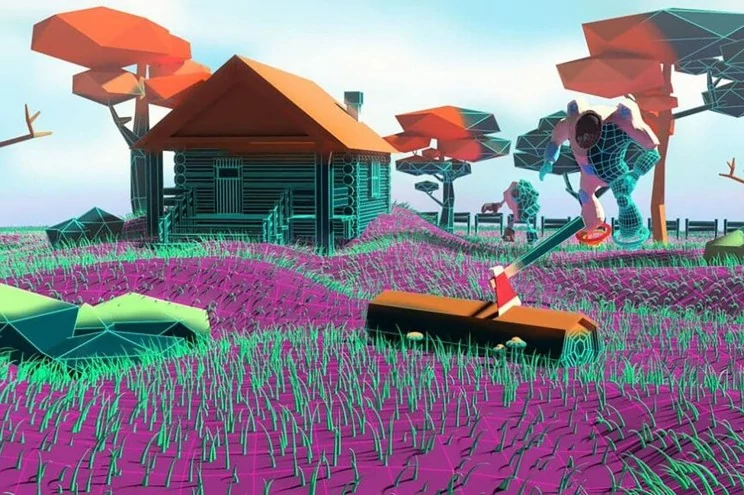
Virtual space in the online world Decentraland. Source: New York Post.
From games to immersive experiences
The most known metaverses are created as games. Minecraft, Fortnite, League of Legends, GTA Online, Roblox and The Elder Scrolls Online are some examples, with others on the way. Games have a guided journey and clear objectives. The metaverse, though, doesn’t necessarily work like this. Even inside games, people gather to participate in events such as concerts. Before changing its brand, Meta announced Horizon Workrooms, a work environment inside the metaverse, in which it is possible to meet with other people in meeting rooms equipped with drawing boards and presentation projectors.
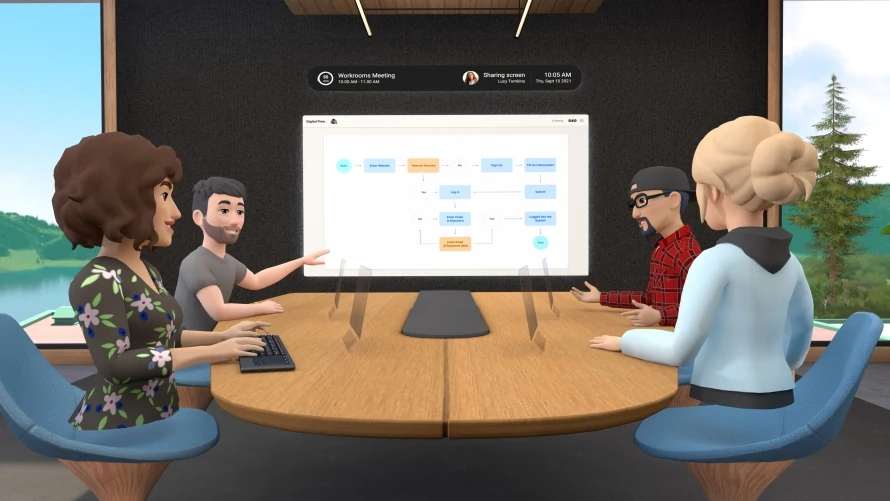
Meeting inside Horizon Workrooms. Source: Meta.
E-commerce and the metaverse
Buying online is a cold and lonely experience, unlike the collective and emotional experience of buying in physical stores. Go shopping is, by itself, an experience. Malls, open air fairs and other commercial centers mix stores and products with attractions and showcase exhibitions that generate conversations, moments, histories and discoveries, even if nothing is bought at that instant. Based on that purchase experience, chinese company Pinduoduo create an e-commerce of agricultural products adopting an online commerce model named interactive e-commerce.
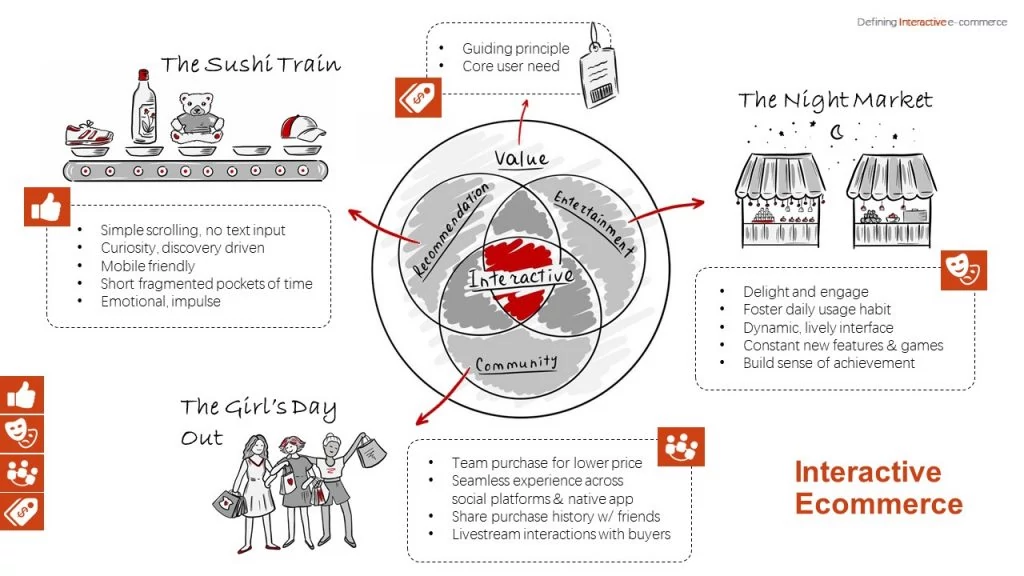
Interactive e-commerce model designed by Pinduoduo. Source: China Channel.
E-commerce visitors can buy products with increased discounts if buying in groups, which the platform stimulates with its team creation feature. Another important aspect of the experience is that it must have room for product discovery, in place of the immediate focus on selling that traditional e-commerce uses today. Finally, the platform rewards people with real products upon achieving certain goals inside in app games. The social aspect of this online experience is connected with the immersive experience from the metaverse, and Pinduoduo’s model could be a glimpse of what buying in the metaverse could look like.
In Brazil, food company Lacta launched its virtual platform for online purchases, simulating a physical store. Using a Google Street View like technology, visitors can navigate around the different sections of the store, check the products and add to a bag those that they want to buy. The store also have two games: a quiz to find the perfect chocolate box, and a game to find three truffles hidden around the store. Upon finding all truffles, visitors are rewarded with 10% discount on all products at the store.
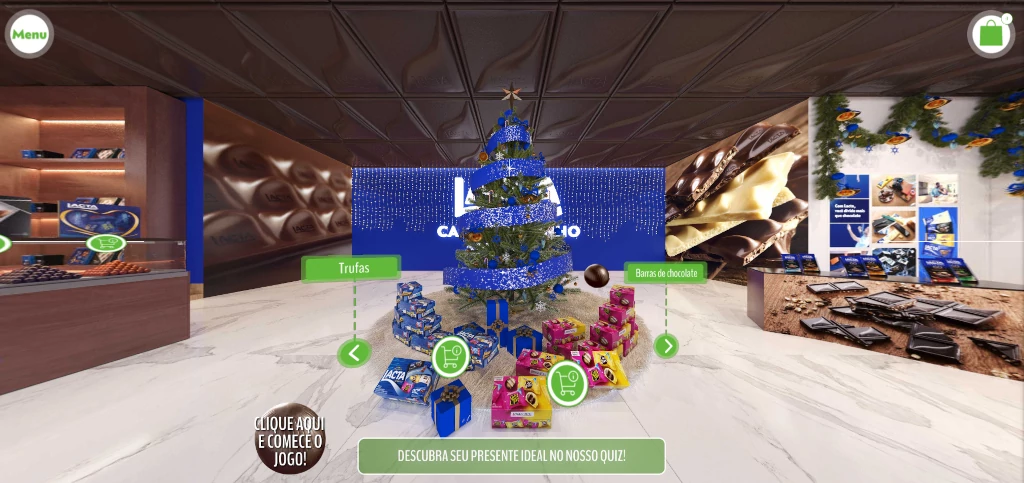
Lacta's virtual store. Source: Autor.
It’s not all perfect
Blockchain can guarantee the identity and existence of avatars on the metaverse, but current technologies are far from able to create safe environments. Horizon Worlds is a metaverse launched by Facebook days prior the publication of this post. In less than a week after its public release, women denounced harassment against their avatars. The platform is equipped with Safe Zone, a feature that blocks anyone to see or speak with avatars while it is activated. The problem with this feature, though, is that whoever feels threatened and activate the feature becomes invisible, while harassers are free to circulate the virtual space, until being denounced. Making the victim invisible and silenced ends up serving as a way to legitimate abusive behaviors in the platform.
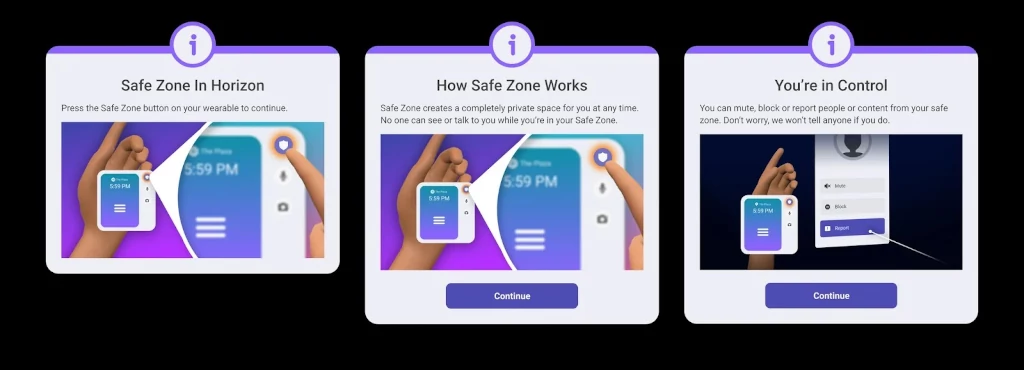
Safe Zone activation steps. Source: Technology Review.
If the well being of those that are already in the metaverse is a topic to be discussed, there’s still the challenge to include those that can't join this space. Tools that allow for immersive experiences are expensive, specially in Brazil. Oculus Quest 2, Meta’s VR headset, costs at least R$ 3,000.00 at the time this post was published. Alternatives with better prices, such as Samsung Gear VR, allow multiple participants in games, but not in other types of experiences.
Data privacy is a subject that has been mainstream for a few years, driven by abusive usage of data from individuals. Up to this date there are no established tools that give individual definitive control over their data, and data protection policies around the world are still maturing. Immersive experiences on virtual environments certainly will need to collect more data, which should bring up questionsabout the potential uses – and misuses – of data that can reveal a lot about our bodies on the hands of virtual reality companies.
The metaverse is at its infancy
Despite the recent growing interest in the topic, the metaverse is at its decades infancy. Today’s technologies allows us to glimpse what’s possible to do in the metaverse, but many barries beyond technological ones must be broken in order to enable the creation of a secure and inclusive metaverse.
If the metaverse really is the next phase of the internet, we can learn from our past successes and mistakes up to now to guarantee that, even before immersive technologies become as popular as smartphones, we get to be welcomed in a safe space to do what we do better on the internet: connect.
Let’s explore the metaverse!
